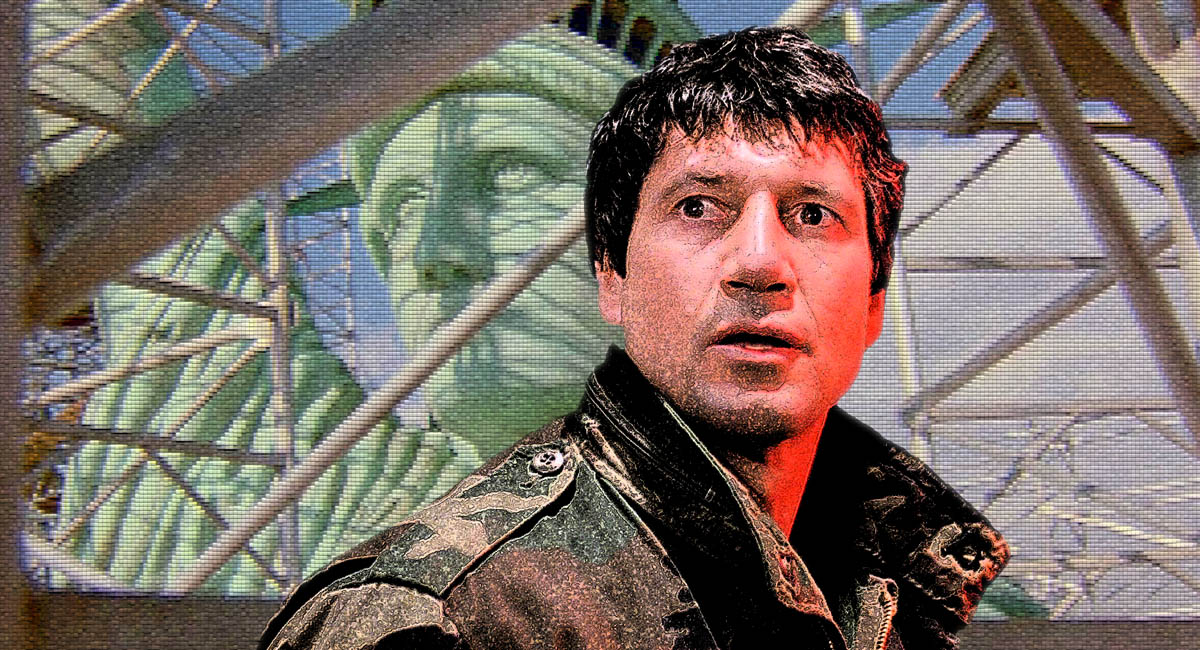
The old-Hollywood-evocative visage of actor Fred Ward has been instantly recognizable for several decades in myriad projects of diverse genres in film and television. Sadly, the American mainstay’s tenure has ended with his passing at the age of 79, which occurred on May 8, as confirmed via publicist on May 13. While Ward’s career initially escalated from a film breakthrough in 1979’s Escape from Alcatraz and a biographical portrayal of astronaut Gus Grissom in 1983’s The Right Stuff, an attempted upgrade to action star status arrived in 1985 with Remo Williams: The Adventure Begins. What resulted was a notorious bomb, one that nevertheless remains beloved.
Unlike today’s superhero-addled audiences, the average moviegoers of 1985 were unlikely to casually throw out the term “franchise,” but Ward found himself headlining such a concept for studios Orion Pictures and Dick Clark Productions, which saw Remo Williams as a prospective American-made, sequel-inviting James Bond-esque action-adventure. The source material centered on a pulp novel series about an American secret agent assassin, The Destroyer, which was launched in 1971 by creators Warren Murphy and Richard Sapir, and would ultimately yield an astounding 150 volumes (mostly written by other authors). The protagonist, a military veteran police officer, found himself framed and facing execution only to be rescued by the secret government organization CURE, which dispenses extralegal justice. Left with no options, he accepts a duress-applied invitation to join the group, leading to a complete change of identity into operative Remo Williams.
Contextually, Ward was still riding Right Stuff-made momentum from his unforgettable fact-based role as Grissom—notably in his portrayal of the astronaut’s personal strife after a famous incident, in which the hatch of his water-landed capsule opened prematurely, ruining valuable flight data, which led to anecdotal accusations from colleagues that he “screwed the pooch.” Yet, his look and acting style made him seem too rough and blue-collar of a choice for someone intended to serve as America’s James Bond. In fact, the selection of a candidate with those very attributes was quite deliberate since the studio wanted Remo Williams to serve as an unassuming, more-lighthearted, less-violent PG-13-rated action alternative to R-rated genre competitors such as the explosive Vietnam-returning onscreen warfare of star Sylvester Stallone’s up-sized sequel, Rambo: First Blood Part II, and the immense Arnold Schwarzenegger’s spree of creative crimson-spilling against daughter-napping terrorists, Commando.
With a certain smooth, seductive martini-sipping MI6 agent on the studio’s collective mind for Remo Williams, the obvious move involved hiring a director with ties to the franchise it sought to emulate. That led the project to director Guy Hamilton, who occupied the big chair for four classic consequential Bond movies in 1964’s Goldfinger, 1971’s Diamonds are Forever, 1973’s Live and Let Die and 1974’s The Man with the Golden Gun; a tenure that showcased original Bond star Sean Connery for the former two and Roger Moore for the latter two. Moreover, the script, adapting Murphy and Sapir’s novel, was written by another Bond alumnus in Christopher Wood, who brought plenty of pertinent experience by adapting—albeit in an extremely over-the-top manner—the novels of Ian Fleming, having penned the screenplays for Moore-starring efforts in 1977’s The Spy Who Loved Me and 1979’s Moonraker. With that set, a solid creative roster for conjuring America’s big-screen default Double-O agent appeared assembled.
Pertinently, The Destroyer novels made Remo’s bare hands into his main weapons, which were implemented for non-lethal combat in the fictional Korean mystical martial art style of Sinanju, courtesy of his mentor and CURE consultant, an elderly Korean man named Chiun. However, the movie adaptation—which would sometimes bear the alternate title, Remo: Unarmed and Dangerous—arguably leaned too far into the anti-Rambo idea and recklessly landed in the realm of fluff. That’s because the role unwittingly brought out Ward’s comedic side, which we would later see more appropriately utilized in 1990’s Tremors as handyman-turned-Graboid-hunter Earl Bassett and as Oscars-crashing crook Rocco Dillon in 1994’s The Naked Gun 33 1/3: The Final Insult. Here, the incidental comedy made Remo into a strawman for a typical self-deprecating stateside trope of a stubborn, ignorant, loud, lazy American. This was especially evident during his unconventionally punishing Sinanju training with Chiun, a character whose casting was seen as controversial even in un-PC 1985, as played by a heavily disguised white American actor, Joel Grey. Yet, while the humiliating start of Remo’s arc from maladroit everyman to martial arts super spy helped further delineate The Adventure Begins from its R-rated heavyweight competitors, it actually degraded its genre status.
The scene that most effectively embodied the misguided tonal nature of Remo Williams’ comical left turn was its showcased Statue of Liberty battle. In a series of clumsy coincidences, Chuin tasks Remo with climbing and navigating the scaffolding covering the iconic Ellis Island monument, which was present for its 1984-1986 centennial restoration, during which the framework appeared prominently in the New York City skyline. However, the evil Stone (Patrick Kilpatrick), an operative of the bad guys, happened to be watching from the ground and proactively attempts to bring a premature end to Remo. Perplexingly, he attempts this sinister feat by paying random New York-accented construction workers to climb up there and knock him down to the ground; a murderous proposition they are gleefully willing to perpetrate for the hefty sum of $30 in cash!
The sequence, which was constructed using scenes shot on a replica Statue of Liberty in Mexico and long shots of the real deal, was Remo Williams’s most elaborate element. Oddly enough, it occurs not in the film’s climax but in the middle, toward the conclusion of Remo’s training phase, which similarly included agility exercises shot atop Coney Island’s Wonder Wheel (a stunt that Ward, to his enduring credit, actually performed himself). Ironically, the elaborate nature of the mid-film fracas relegates the film’s actual climax into a rather forgettable affair. Indeed, the scene, despite being excessive plot-wise, was touted proudly and prominently in the film’s trailer, posters and other promotional ephemera. Moreover, it also served as the motif-matching backdrop of the music video for “Remo’s Theme (What If)” by solo-venturing Styx singer/guitarist Tommy Shaw, in which the performer utilized the same techniques to appear as if he’s rocking out atop the scaffolding-covered statue akin to Remo himself.
Unfortunately, Remo Williams: The Adventure Begins would not live up to the prospect of sequels implied in its very title. Indeed, the premise of an American schlub James Bond tangling with Miller-drinking teamsters atop the Statue of Liberty failed to entice moviegoers upon the film’s October 11, 1985 premiere. Landing low at #4 with a $3.3 million gross for its opening weekend, the film had nowhere else to go but down, and became unranked by the middle of November, leaving an anemic total of $14.3 million for its domestic-only release. Yet, that palpable disappointment did not initially deter the would-be franchise from making an attempted medium migration since 1988 saw the arrival of a TV movie and de facto series pilot, Remo Williams: The Prophecy. However, movie cast members like Ward, Grey and even a pre-Star Trek: Voyager Kate Mulgrew’s Major Rayner Fleming were nowhere to be found since they left the damaged branding. Thusly, Jeffrey Meek starred as Remo, opposite Roddy McDowall as Chiun. That small screen endeavor failed to yield any fruit, and relegated the Remo franchise to a bin of forgotten adaptations, even as The Destroyer novels continued. While reboot projects have been mooted over the years, nothing has manifested yet.
Regardless of any initial stigma from its failures, posterity has been far kinder to Remo Williams: The Adventure Begins than its contemporaneous treatment. In fact, while movie fans are more likely to know Ward from the Tremors franchise or even his very last role before retirement, a 2015 two-episode run on the HBO series True Detective, the earnest array of kitsch from that one headlining action foray still stands out as a career highlight. It is a legacy that any actor should be proud to carry, making the word Remo synonymous with a now-beloved cult classic, and an energetically inspirational orchestral leitmotif.

